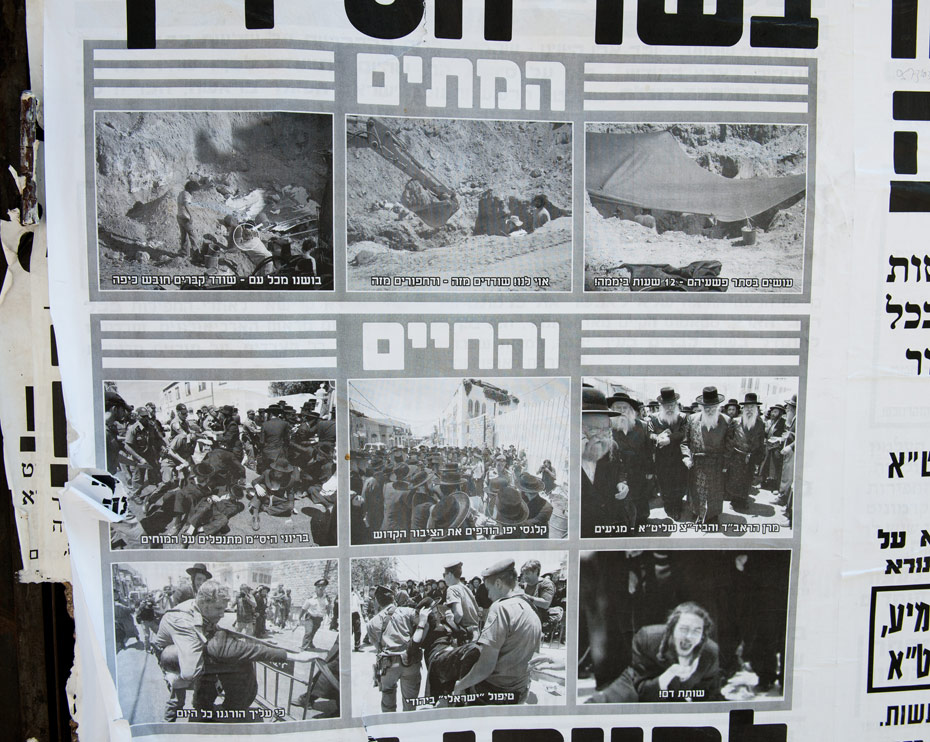The archaeologist draws inspiration from Shore’s photography for an essay on the battle for Israel’s ancient secrets

Stephen Shore’s new book From Galilee to the Negev chronicles the photographer’s emotional journey through the West Bank, capturing the beauty, tension and contradictions of the region and the communities who uneasily inhabit the Israeli and Palestinian territories. Accompanying the images are essays from several writers, including chef, restauranteur and food writer Yotam Ottolenghi and The New Yorker’s Jane Kramer.
Here we present an extract from Jodi Magness’ musings on the battle between archaeologists and the Ultra-Orthadox Jewish population, inspired by Shore’s image above. Magness is an archaeologist specialising in ancient Palestine in the Roman, Byzantine and early Islamic periods.
The ongoing battle between archaeologists and Ultra-Orthodox Jews is one manifestation of the Israeli religious and culture wars, which pit different segments of the population against each other. This is a photograph of a poster in an Ultra-Orthodox neighbourhood, which condemns archaeologists for allegedly excavating ancient Jewish graves. Ultra-Orthodox Jews – or haredim (Hebrew for ‘God-fearers’) – oppose disturbing burials in any way because they believe in the future, physical resurrection of the dead.
The poster is divided into two parts: an upper strip with one row of three photos and a lower strip with two rows of three photos each. The photos in the upper strip, labelled ‘The Dead’, show archaeologists supposedly in the act of desecrating ancient burials. Each photo has a caption: the one on the upper left, for example, describes an archaeologist who is wearing a kippa (religious skullcap) as a shameful ‘grave robber’. The two lower rows of photos are labelled ‘The Living’. They show Ultra-Orthodox Jews protesting against archaeological excavations, with the arrest and dispersal of protestors. The captions condemn the Israeli police and other authorities for violence against other Jews, including one on the lower right that reads ‘butcher!’ – an allusion to Nazi Germany.
All archaeologists working in Israel are caught up in this conflict, which has evolved and escalated over time, and is as much about politics as it is about religion. Archaeology played an integral role in the Zionist enterprise, legitimizing the establishment of the State of Israel by uncovering ancient Israelite or Jewish settlements and thereby bolstering contemporary claims to the land. Yigael Yadin, who was arguably Israel’s most famous archaeologist, and Moshe Dayan, who was an amateur archaeologist and an antiquities collector, both served as chiefs of staff of the Israel Defense Forces (IDF). Yadin excavated such crucial sites as biblical Hazor and Herod’s fortified palaces atop the mountain of Masada. When I first arrived in Israel in the early 1970s archaeology was considered the national pastime, and Yadin and Dayan were larger-than-life heroic figures. At that time the Ultra-Orthodox were a small and marginal part of the population, and the religious parties wielded little political power.
After Menachem Begin became prime minister in 1977 his Likud party formed a ruling coalition with religious parties. Since then the Ultra-Orthodox population has increased dramatically while secular population growth has stagnated, and more religious parties have been established and have become increasingly influential in Israeli politics. To woo these parties into coalitions, various concessions have been made. Archaeology was an easy and early sacrificial lamb on the altar of political necessity. By the late 1970s the Ultra-Orthodox had begun targeting excavations in an attempt to shut them down, protesting the alleged desecration of ancient Jewish graves. Although many of the protestors are presumably sincere in their belief that burials are being violated, in most cases there is no scientific evidence to support this. Large numbers of animal bones turn up in all archaeological excavations, but rarely are undisturbed human remains or burials found.
From Galilee to the Negev is available now in hardback through Phaidon (£75)




